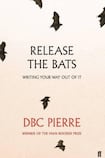
Born in Australia but raised in Mexico, DBC Pierre grew up an outsider, and a literary vocation made a virtue of necessity. "I had to study the gap between values," he recalls in Release the Bats: Writing Your Way Out of It, "which meant learning where they came from and what was behind them." The currency of literature, he explains, is the discrepancy between objective reality and the complex matrix of constructed truths that makes up our social world; the writer's business is to inhabit and illuminate that realm.
Pierre, who is best known for his Booker prize-winning 2003 debut, Vernon God Little, has written a lively and congenial how-to guide for aspiring writers, offering advice on both the motivational and the technical aspects of novel-writing.
Received wisdom places a great emphasis on structure and planning, but Pierre is sceptical. He believes “the job is better split and performed backwards; don’t build a house and furnish it but knock up some furniture on a binge and see what architecture it wants”. Pierre advocates a two-stage process: an initial, feverish state of expulsive abandon, followed by a “carpentry” stage of considered whittling.
He relates his first successful trial of this technique, evoking a sense of quiet euphoria as the book began to take shape: “tension increased by ending chapters here rather than there, sentences grew strong by losing words, pages tightened as dull paragraphs fell out. I focused on meaning and forward motion, everything had to push the narrative or it was out. . .”
Pierre offers sound counsel on such vexed questions as whether one should listen to music while writing (yes for the first draft stage, no thereafter), drugs (they "work for the art but not so much the craft") and caffeine intake ("cut loose for the first draft and final push, throttle back in between"). He makes some cute observations on the death of realism – "the laces of reason have come undone and made naturalism of satire" – and the consequent importance of plausibility in fiction, enumerating several juicy nuggets he felt compelled to omit from Vernon God Little because, though factually true, they seemed too preposterous. He advises that characterisation works best when gently allusive: "don't explain a character. Show us what moulds him." The little tics and eccentricities are "the real voices of a story".
What with the thousands of manuscripts rejected by publishers each year and the proliferation of creative-writing courses, there is clearly a market for books like this. But what does this one offer that other manuals – and there are a good many available – don't? The aspiring writer seeking guidance on the various technical components of novel-writing would probably be better off consulting a more lucid work, such as David Lodge's The Art of Fiction (1992), which covers most of the subjects adumbrated by Pierre – surprise, characterisation, subplots, and so on – and several more besides, with rather greater poise and elegance.
The distinguishing trait of Release the Bats is, in truth, the author's voice, a kind of surfer-dude pep-talk register, blending chummy anecdotal bonhomie with a wearisome propensity for waxing superabundantly expletive. Whether free-standing, adjectival or compound, there is a f**k of one kind or another at every turn: ratf**ks, headf**ks, f**kers, f**king this and f**cking that. Bad things "suck" and are "f**ked-up", "shit" and "crap". You will love it if you're 17.
Generating a sense of urgency is important to DBC Pierre. We know this because he tells us, and in Release the Bats he practises what he preaches. But a good deal of it falls flat for trying too hard. The jury is out, for example, on whether "who're" is really a contraction at all. (Try saying it aloud: the syllable count is not diminished, unless you pronounce it like "whore", which brings its own problems.) And while the regressive stoner diction might engender a certain intensity over a short span, it grates horribly over 250 pages.
Pierre’s formula for constructing compelling narratives (hook; goal; conflict; failure, followed by dilemma; decision; action; hook) will be useful if you’re trying to write one type of novel – or a screenplay – but redundant if you’re attempting anything else. Given that much of the literary fiction that has captured readers’ imaginations in recent years has drawn from other wells, such as urban psychogeography (Teju Cole) or Proustian memoir (Karl Ove Knausgaard), this is a limitation.
Wearing his influences on his sleeve, Pierre has punctuated this text with choice quotes from the likes of Charles Bukowski, Hunter S Thompson and Ernest Hemingway. These men were, aesthetically speaking, of their time; Pierre, by contrast, appears stubbornly anachronistic, his sensibility locked in a countercultural moment that has long vanished.
Houman Barekat is a literary critic














